The condition known as ‘stunting’ is an extremely common and often dangerous condition among many bird species. It can result in a range of life-long difficulties, illnesses and disabilities that can severely impact the quality and length of a birds life if left untreated. Luckily, with the correct knowledge, supplies and routines, stunting is one of the very few conditions that can be effectively treated from home.

What Is Stunting?
Stunting is a condition that primarily begins in the first few weeks of a birds life, when it is still in the process of developing vital organs and body structures. There are many known causes of stunting such as neglect, underfeeding, malnutrition and dehydration, all which are attributed to the quality and quantity of food and care a chick receives while in the nest.
Stunting can never be fully fixed. A bird that has suffered stunting at a young age will always have the effects of this stunting period present, such as some underdeveloped organs or generally smaller than average size. However, with a little help, the severity of these effects can be heavily minimized, helping the chick to grow into a healthy and happy adult.
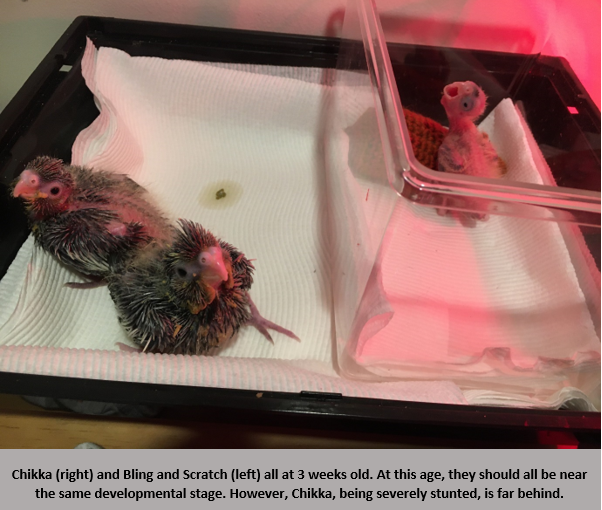
What Does Stunting Look Like?
To the experienced chick-raiser, stunting is easily identifiable due to its set of common physical and behavioral characteristics. Below are a list of the common identifiers that you’re likely to see in a stunted chick:
Physical
- Large head in comparison to body
- Large nares (nostrils)
- Small, thin wings and toes
- Small overall size compared to clutch mates or other similarly aged chicks
- Low weight and slow or non-apparent weight gain
- Eyes failing to open at the usual time for the species
- Late feather development
Behavioural
- Holding wings out at sides while begging and moving
- Constant begging
- Tendency to overeat
- Behaviours that are unusual for the chicks developmental stage, such as strong walking abilities, feet gripping and flapping wings while the chick is still not feathered or is significantly small
Due to stunting usually being caused by external factors, it’s very common for chicks to have another condition alongside stunting. These conditions can include diarrhea, sour crop or slow crop, liver and kidney disease, and dehydration.

How Do Birds Become Stunted?
There are a number of reasons a chick may become stunted, but all are due primarily to the care a bird receives in the nest. Some causes include:
- Underfeeding
- Receiving food that is not nutritionally appropriate
- Abandonment resulting in underfeeding
- Generally small size or young age, which can cause a chick to no be unable to compete with older siblings for food and therefore receive little to no food from parents
- Inappropriate brooding temperatures
- Dehydration caused by lack of food or lack of water in food – usually apparent in chicks due to red or dark skin colouration, visible blue veins on head or abdomen, flaky skin and excessive begging behaviours
- Yeast or bacterial infection in the crop or gastric system
- Underlying congenital condition

What Happens if Stunted Birds Are Not Treated?
Stunting is notoriously dangerous for young birds due to its interference with not only size, but also with the growth of vital organs within the bird’s body. A bird that has been stunted for a prolonged period of time will likely have permanently underdeveloped organs and body systems, which is likely to effect the bird’s quality and length of life. Organs that are commonly effected are the liver – hence why stunting is so commonly associated with liver disease – the kidneys, the respiratory system and the nervous system.
Stunting that is not corrected in young chicks will likely lead to death due to these underdeveloped organs and bodily systems and the resulting conditions caused by this. For example, if a bird is stunted due to malnutrition, it will not receive enough energy to complete everyday functions such as properly digesting food, which will result in the shut-down of the digestive system and its related organs. Similarly, a chick that is kept at a brooding temperature that is too cold for its age will not be able to digest its food at an appropriate speed, resulting in a lack of energy and eventually, the shutdown of internal organs.
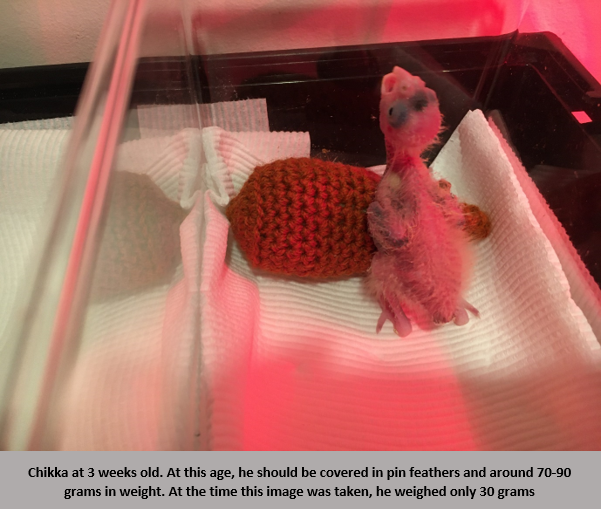
How is Stunting Fixed?
Find a list of useful hand-feeding links at the bottom of this article.
Stunting is corrected by treating the underlying cause.
Dehydration
Dehydration is one of the most common causes of stunting in birds. It occurs when a bird does not receive enough water in its food, or is kept at a brooding temperature that is too high for its age. A dehydrated chick will be dark red in colour or have pale, flaky skin, will have prominent blue veins on the head and abdomen, will have a lack of energy and may beg excessively – which can be easily mistaken by hand-rearers as hunger rather than thirst.
To fix this issue, a thermometer must be placed in the nest in order to identify the brooding temperature, allowing it to be lowered according to the species’ recognized healthy brooding temperature. If the chick is hand reared, ensure the instructions on the chick’s formula are adhered to, as this ensures the amount of water in the chick’s food is appropriate.
If the water to formula ratio follows the formula’s given instructions, but the chick still appears dehydrated, you will need to re-hydrate the chick using an electrolyte solution. Commonly used electrolyte solutions include pedialyte and gastrolyte. Use a syringe to give the chick approximately 1-2 ml of the solution (warmed up) before or after feeding. If the chick will not accept the formula due to the taste (flavourless options of pedialyte are available, but can be difficult to locate) you may mix the solution with the chick’s formula, although this option does lessen the amount of extra hydration for the chick. Avoid any flavouring that might contain citrus. Continue to feed the chick the solution until it appears to be rehydrated and the chick’s overall growth increases.
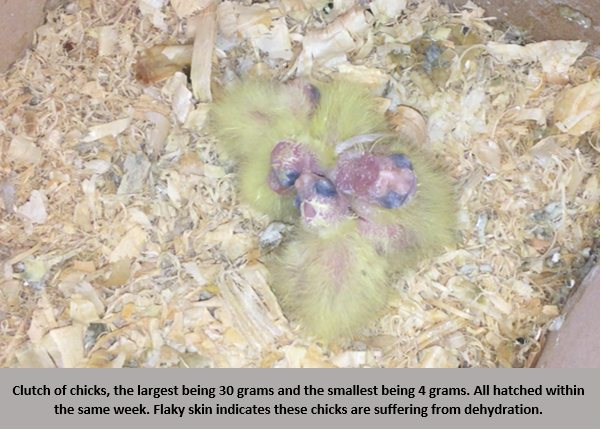
Malnutrition
Chicks that are stunted due to malnutrition are far more common within parent-raised clutches than hand-raised clutches. This is because commercial hand-rearing formulas contain high nutritional values and when fed the appropriate amount at the correct consistency, will be very unlikely to cause any negative effects on healthy chicks. Parent-raised cockatiels, however, depend primarily on their parents for nutrition. Parent birds will likely not receive the correct nutrition to produce food that is similar to high-quality formula, and the parents may not themselves be fed appropriately nourishing food, passing on this lack of nutrition to much more vulnerable chicks (common with budgies and cockatiels that are primarily seed-fed, without the variety of vegetables, fruit and other foods needed for a healthy diet).
To assist parent-reared chicks, add vegetables and fruits to the parents’ diets along with seeds. Unfortunately, this method is not a quick fix and is better used before parents begin mating, as birds that have not been introduced to fruit and vegetables before will be very unlikely to begin eating them if they currently have chicks in their care.
The best option for a malnourished parent-reared chick would be to either co-parent the chick, or remove the chick from the nest entirely for hand-feeding. Co-parenting involves providing extra feedings for chicks while they are in their parents’ care. These feeds are often small and few, to prevent the crop from becoming slow or overstretched (occurs when there is too much food in the birds crop – which is the sac below the neck where food is stored for digestion). Hand-rearing will likely be the most effective option in this instant, as it will require only formula feeds and at frequent intervals, encouraging weight gain and upping nutrition, but this may not be the best option for those who are unable to tend to chicks at the necessary feeding hours.
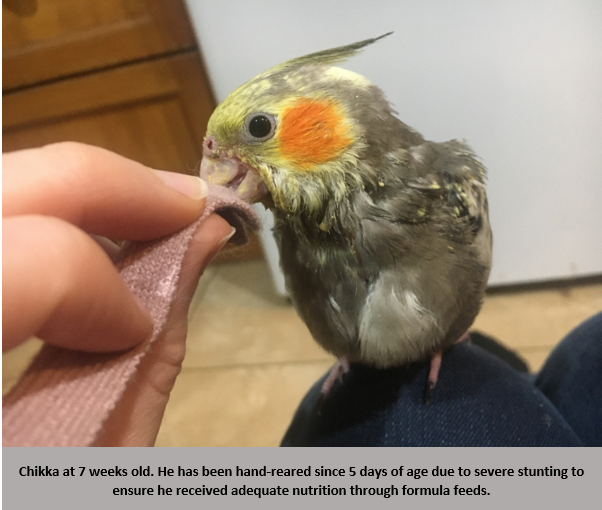
Underfeeding
A chick that is underfed will be identified by a crop that appears empty often, begs constantly and is uncharacteristically small compared to other chicks in the clutch. Underfeeding most commonly occurs with the chicks that were last to hatch in a clutch. Because of the smaller stature and higher vulnerability of younger chicks, they are unlikely to be able to compete with a large clutch of older chicks, meaning they will receive little food in comparison.
To fix this problem, you may consider removing the underfed chick for hand-feeding, or co-parenting this chick to ensure it receives the correct amount of food necessary for growth.
Yeast and Bacterial Infections
Yeast and bacterial infections are incredibly common among hand-reared chicks, and are usually caused by insufficient sanitation of feeding tools or incorrect formula. If feeding tools are not sanitised before use they may harbour yeast or bacteria, which will then enter the chick’s system at feeding. Yeast infections, commonly gastric yeast (aka megabacteria), and bacterial infections will usually form within a chick’s crop of gastric system and cause diseases such as slow crop, sour crop (when old food sits at the bottom of the crop with yeast and ferments, producing a lethal gas) and liver disease.
Chicks with bacterial and yeast infections will not be able to properly digest their food and this bacteria and yeast may also attack other systems of the chick’s body, lowering a chick’s already poor immune system. This lack of proper food and therefore lack of energy will cause stunting.
These infections can be difficult to treat, as they often require veterinary diagnosis as to the type of yeast or bacteria so an antibiotic specific to the strain can be given. However, there are some common methods of treating possible yeast and bacterial infections before they become severe (note: bacterial and yeast infections are emergencies and require the assistance of an avian vet. These methods should only be used if a vet is unavailable or the issue is in its very early stages).
- Mix a solution of 1/2 formula and 1/2 applesauce and feed to the chick. Applesauce in general speeds up the digestive system, but will also cause diarrhea and loss of fluids. For this reason, it is necessary to limit the amount of applesauce feedings to one or two per day.
- Give the chick Nystatin (aka Nilstat). For a 3 week old chick, a dosage of 0.5ml every 12 hours is recommended if the infection is likely in its early stages and the same dosage every 8 hours is recommended if the infection is believed to be severe. This will attack any fungal infection, such as avian yeast, if present in the chick’s system. Nystatin is a relatively safe medication to use, as accidental overdoses are generally not harmful, and Nilstat can be sourced over the counter at pharmacies.
- Mix a small amount of apple cider vinegar in the chick’s formula or water if the chick is able to drink by itself. Only a drop or two should be necessary. This attacks any bad bacteria or yeast in the bird’s system.
If a chick is believed to have a bacterial or yeast infection, it should be isolated from any other birds due to the condition’s contagious nature. Ensure the isolation brooder is kept at the appropriate temperature and that paper toweling is used as a substrate so droppings can be monitored.

Abandonment
Chicks may be abandoned by their parents for a number of reasons including parental inexperience, confusion or stress due to an overabundance of chicks, leading to the parents feeling they will be unable to sufficiently keep all chicks alive and therefore abandoning one of the chicks to focus on the others. However, as unfortunate as it is, the primary cause of chick abandonment is the presence of an underlying illness or disability in the abandoned chick.
A parent bird’s goal is to ensure as many chicks reach adulthood as possible. If a parent perceives a chick to be unwell, it will abandon this chick, either by removing it from the nest or no longer feeding it, to ensure the safety of the other chicks within the clutch. This is an effective method for parents, as there are many conditions that can be highly contagious among chicks and cause a very high number of fatalities. Chicks that are abandoned are obviously not going to receive the amount of nutrition or care necessary for growth, leading to the chick becoming stunted.
Abandonment can often be heartbreaking to witness. Therefore, if a chick is to be given a chance, it is necessary for the abandoned chick to be hand-reared. Using a quality formula, an appropriate brooder and sufficient feeding schedules, the chick may be nursed back to health and growth may continue. However, it is necessary to note that parent birds know best when it comes to their chicks. Abandoned chicks may not be able to be nursed back to health due to the pre-existing conditions that were the original cause of abandonment, no matter how much effort is put in to helping it.
Underlying Congenital Diseases
Much like humans, birds can be born with diseases and difficulties that can affect their quality of life. These conditions can, consequently, result in the stunting of young birds either because the parents are unable to provide the appropriate specific care for this chick, or because the condition itself is ultimately fatal. Some of the most common congenital conditions in birds are respiratory conditions – which prevent a bird from being able to breathe properly – heart conditions – which may result in high blood pressure, heart palpitations, heart attack or stroke – and neurological problems such as brain damage.
These conditions may prevent the chick from being able to develop organs properly and possibly prevent the chick from being able to digest food or digest specific nutrients to allow for growth.
Congenital problems are very unlikely to be solved from home and will require intervention from an avian vet, who may be able to provide supplements to encourage growth and advice on how to further proceed with the chick’s care.
However, it should also be noted that some congenital conditions, such as malformed limbs and beaks, may look similar to the symptoms of stunting. If a chick appears to have these types of abnormalities, it may be unable to compete with fellow chicks in the nest for food and may end up abandoned or underfed by parents. In this case, it is best to remove it from the nest for hand rearing.

What Happens to Stunted Birds in the Long Run?
Birds that have undergone stunting will always be affected in one way or another. This may be barely apparent if the stunting was corrected early on in the chick’s life, causing problems such as smaller stature and smaller than average organs.
However, if a chick has been stunted for a prolonged period of time before being corrected, the effects of stunting may be far more apparent. Underdeveloped organs may shorten the bird’s overall lifespan or cause significant ongoing health issues, the bird will likely be smaller than other birds of its age, meaning it may be an easy target for bullying and may not be able to be housed with other birds, and brain damage may occur. These birds may require a significant amount of veterinary assistance and human intervention throughout life.
That is not to say that a severely stunted bird will not live a relatively happy life, though, as there are many stories of birds that have been stunted as chicks and assisted through life into adulthood.
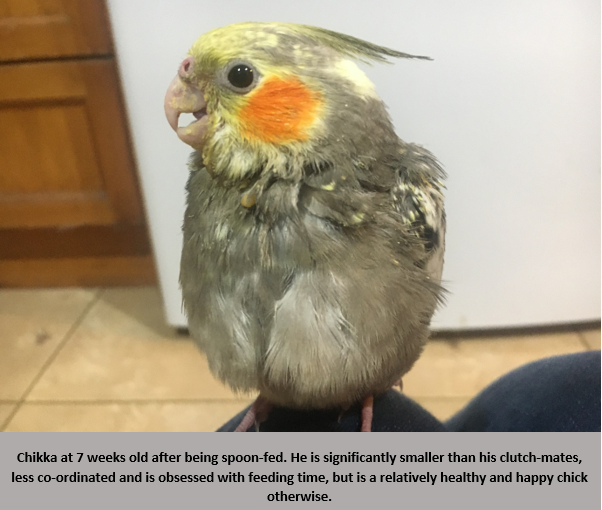
Resources
https://codylwrites.com/2020/03/08/hand-rearing-common-cockatiel-chick-illnesses-and-how-to-cure-them/
Click on the link for a printable logbook to measure cockatiel chick weights, feedings and developmentDownload
Article that covers hand-feeding techniques and tools necessary:
https://www.cockatiel.com/handfeeding.html
General article about birds and hand-feeding:
http://www.vetzone.com.au/Birds/Articles/Article/tabid/1964/ArticleID/2037/Guidelines-for-Hand-Feeding-Baby-Birds.aspx#.Xq_wFagzbIU
VetaFarm videos, including hand-rearing advice and informative lessons:
https://vetafarm.com.au/videos/
Link to purchase the book A Guide to Incubation and Handraising Parrots:
https://birdkeeper.com.au/products/a-guide-to-incubation-and-handrearing?variant=29193748283491
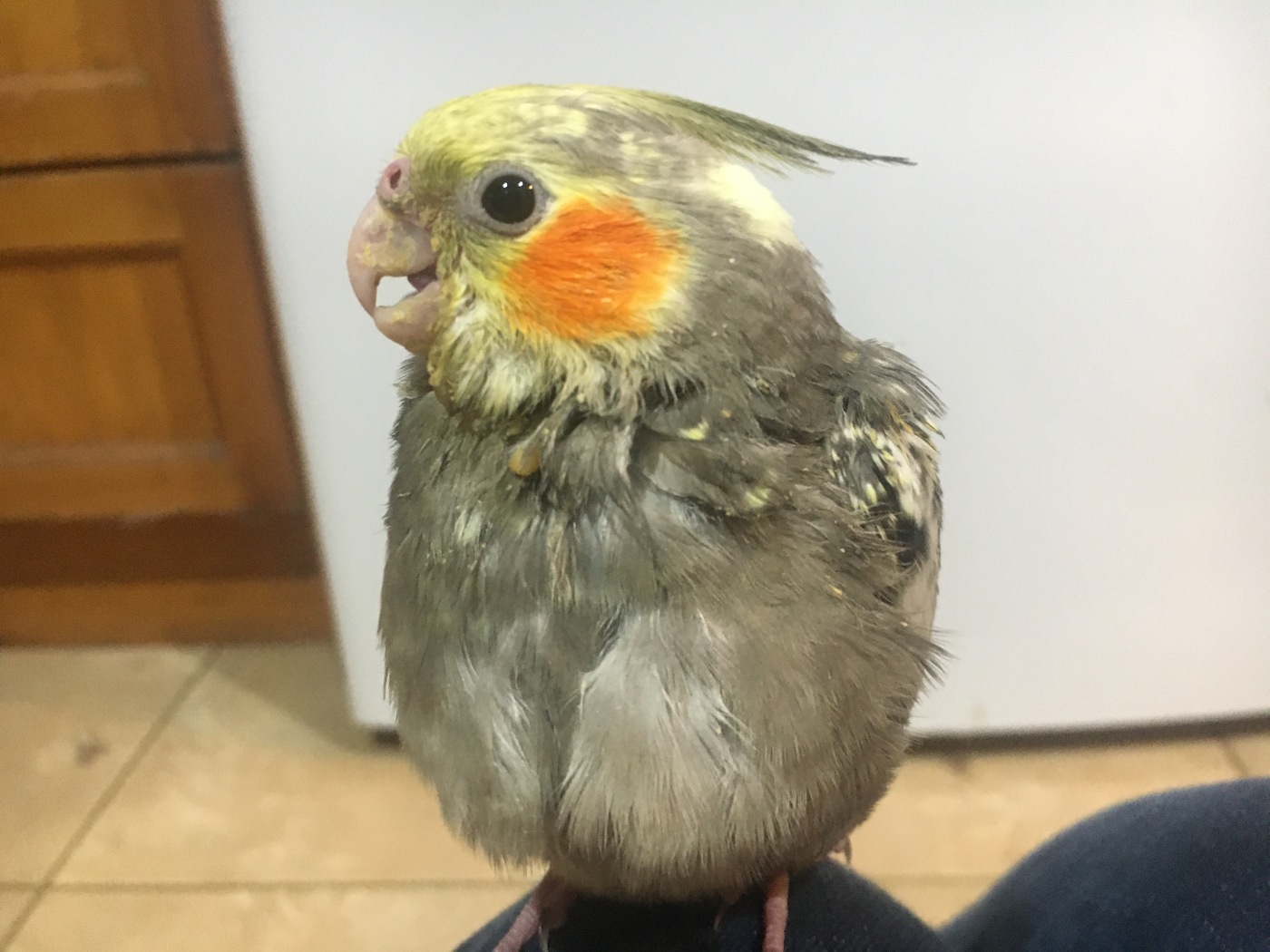
Great article! I have a stunted tiel– what we did to help her was we took all of her siblings out of the nesting box/feeding basket and we would put her in there alone with her parents and they fed her. What was happening is her siblings were competing with her for food and since she was little she was too quiet. She is now 7 yrs old and 85 grams
LikeLike